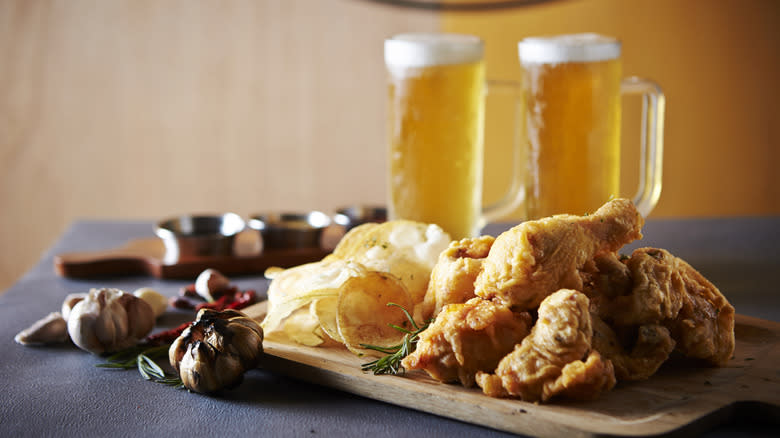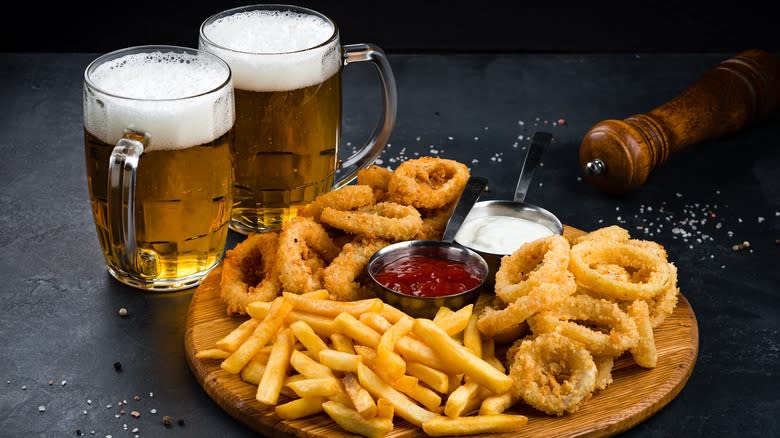Your Beer Order Can Make Or Break The Taste Of Spicy Fried Food

Is there anything more refreshing than wolfing a basket of spicy chicken wings and washing the whole thing down with a cold, crisp beer? There's something uniquely purifying about the enjoyable suffering of your mouth on fire and nose running like it's in a 5K marathon. But you can truly destroy this balance of pain and pleasure if you're drinking the wrong beer with your spicy fried foods –- luckily, we're here to help. In an exclusive interview, Daily Meal talked to Jessie Massie, Taproom Executive Chef at Sierra Nevada Brewing Co., to give guidance on the dos and don'ts of pairing beer with spicy food.
"If you want to amplify the kick in your spicy food, choose a hoppy beer with more intensity in the bitterness, or an IBU rating of 55 or higher," Massie said. "But if you like a more balanced approach, I recommend a beer that has lower bitterness, or a lower IBU rating." We'll get into IBU a little bit later, but the long and the short of it is this: The more bitter a beer is, the more it can (potentially) intensify the heat of the spice you're eating. If you're a glutton for punishment, you might just enjoy a super-hoppy India Pale Ale with your next plate of jalapeno poppers. If not, there are other options.
Read more: 10 Of The Healthiest Beers You Can Drink
The IBU Scale And Spice

IBU stands for International Bitterness Units; the scale of beer bitterness which ranges from 0 to 120. Beers with high levels of hops typically appear at the higher end of the IBU scale. The human tongue can detect the alpha acids and polyphenol content in beer, and that's what registers in the brain as bitterness. The reason why some people like bitter beers is as scientific and subjective as the reason some people love spicy food.
It isn't always the case that beers with a higher IBU amplify the spiciness of food: Typically, low-IBU sour beers can really bring the heat. Carbonation is also an aggregator of spice irritation, so when it comes to pairing your beer with the right food, you should consider a number of things: How bitter is your beer? How fizzy? Does your beer have a malty or a crisp finish? These are the considerations that will make or break your spicy food-and-refreshment experience.
Which Beer Should You Choose?

So how do you strike a balance between beer and your basket of spicy fried calamari? According to Massie, "Dry, crisp, full-flavored lager-style beers like a Czech-style pilsner are a solid choice because they'll cleanse and refresh the palate so you can dive in for another spicy bite." But if you like a side of gentle suffering with your meal, you can turn up the heat and grab a Sierra Nevada for a nice bitter punch along with the burn.
Nitrogenated stouts like Guinness balance heat and pair well with dishes like Indian pakora with green chilies. Milk stouts are also great options for spicy meals because they're less fizzy, lower on the IBU, and contain lactose -- which helps combat capsaicin, the hydrophobic chemical responsible for spice. If you like the heat but want to have a less intense experience with it, you can try malty and sweeter beers. Sugar tricks the brain into minimizing the perception of spice heat. The next time you go for spicy fried chicken and you're not sure which beer to choose, decide how much heat you're ready to take and remember Massie's sound advice about where the beer sits on the IBU scale.
Read the original article on Daily Meal.

